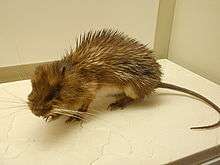Armored rat
| Armored rat | |
|---|---|
 | |
| Scientific classification | |
| Kingdom: | Animalia |
| Phylum: | Chordata |
| Clade: | Synapsida |
| Class: | Mammalia |
| Order: | Rodentia |
| Family: | Echimyidae |
| Genus: | Hoplomys J. A. Allen, 1908 |
| Species: | H. gymnurus |
| Binomial name | |
| Hoplomys gymnurus (Thomas, 1897) | |
The armored rat (Hoplomys gymnurus) is a species of rodent in the family Echimyidae.[2] It is monotypic within the genus Hoplomys. It is found in Latin America, from northern Honduras to northwest Ecuador. They have a range of spines on their back and sides, although they are born with soft fur – the spines begin growing after the first month.
Description
Part of the infraorder Hystricognathi, they are more closely related to porcupines than the common brown rat.[3] Adults weigh between 218–790 grams (0.481–1.742 lb) with males weighing more on average than females, and have thick spines on the back and sides of the body,[4] which measure up to 33 millimetres (1.3 in) and 2 millimetres (0.079 in) in diameter.[5] The head and body measures between 220–320 millimetres (8.7–12.6 in) in length, with the tail adding another 150–255 millimetres (5.9–10.0 in).[5] The color of the armored rat range from black to reddish brown, and has a pure white underside. They are similar in appearance to Tome's spiny-rat, but the eyes of the armored rat are smaller and they have a longer snout.[4] Its diet includes fruit, insects and green plant matter. The normal litter size is one to three, and the fur on the offspring is soft with the spines only developing after the first month.[4]
Habitat
The armored rat is nocturnal species, which occupies burrows. These burrows are usually positioned in steep banks close to a water source, and can measure up to 2 metres (6.6 ft) in length before reaching a nesting chamber.[4] They are distributed from northern Honduras to northwest Ecuador, from lowlands up to around 800 metres (2,600 ft) in altitude.[4]
References
- Specific
- ↑ Gómez-Laverde, M.; Anderson, R. P.; Emmons, L. & Samudio, R. (2008). "Hoplomys gymnurus". IUCN Red List of Threatened Species. Version 2008. International Union for Conservation of Nature. Retrieved 5 January 2009.
- ↑ Woods, C.A.; Kilpatrick, C.W. (2005). "Infraorder Hystricognathi". In Wilson, D.E.; Reeder, D.M. Mammal Species of the World: A Taxonomic and Geographic Reference (3rd ed.). Johns Hopkins University Press. p. 1583. ISBN 978-0-8018-8221-0. OCLC 62265494.
- ↑ Reid, Fiona (2010). The Wildlife of Costa Rica. Ithaca, N.Y.: Comstock Pub. Associates. p. 17. ISBN 978-0-8014-7610-5.
- 1 2 3 4 5 Reid, Fiona (1997). A Field Guide to the Mammals of Central America & Southeast Mexico. New York: Oxford University Press. pp. 251–252.
- 1 2 Nowak, Ronald M (1999). Walker's Mammals of the World. Baltimore: Johns Hopkins University Press. p. 1689. ISBN 978-0-8018-5789-8.
- General
- Woods, C. A. and C. W. Kilpatrick. 2005. Hystricognathi. pp 1538–1600 in Mammal Species of the World a Taxonomic and Geographic Reference 3rd ed. D. E. Wilson and D. M. Reeder eds. Smithsonian Institution Press, Washington D.C.
External links
| Wikimedia Commons has media related to Hoplomys gymnurus. |
